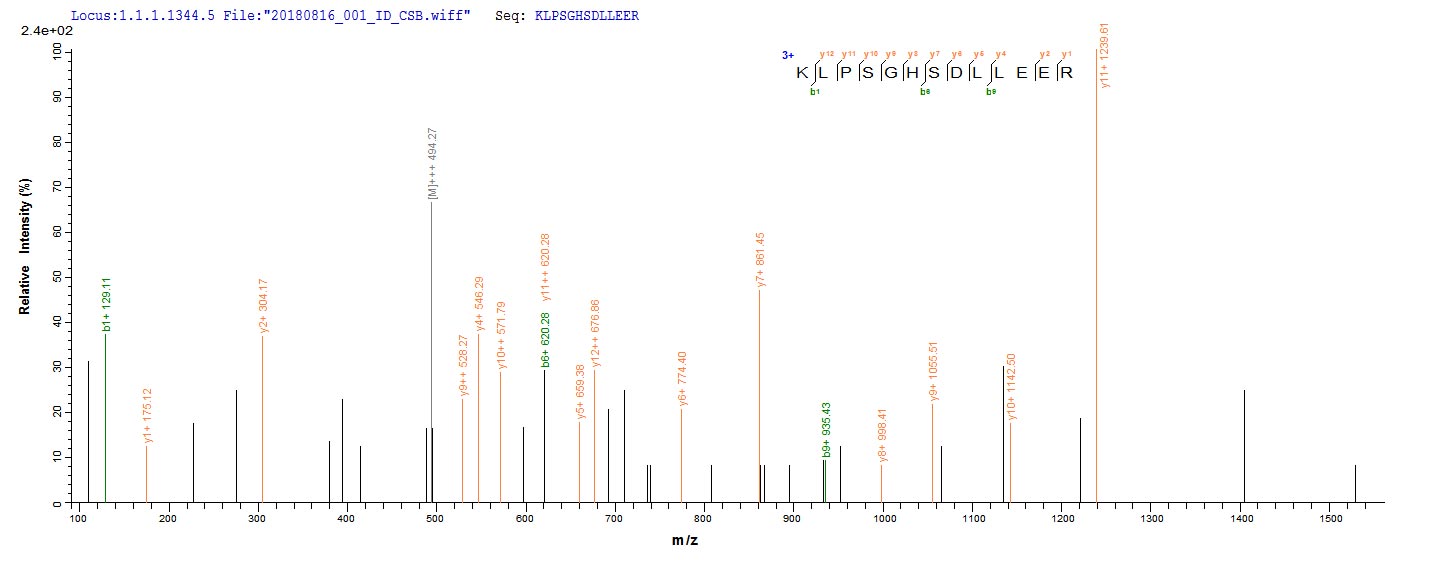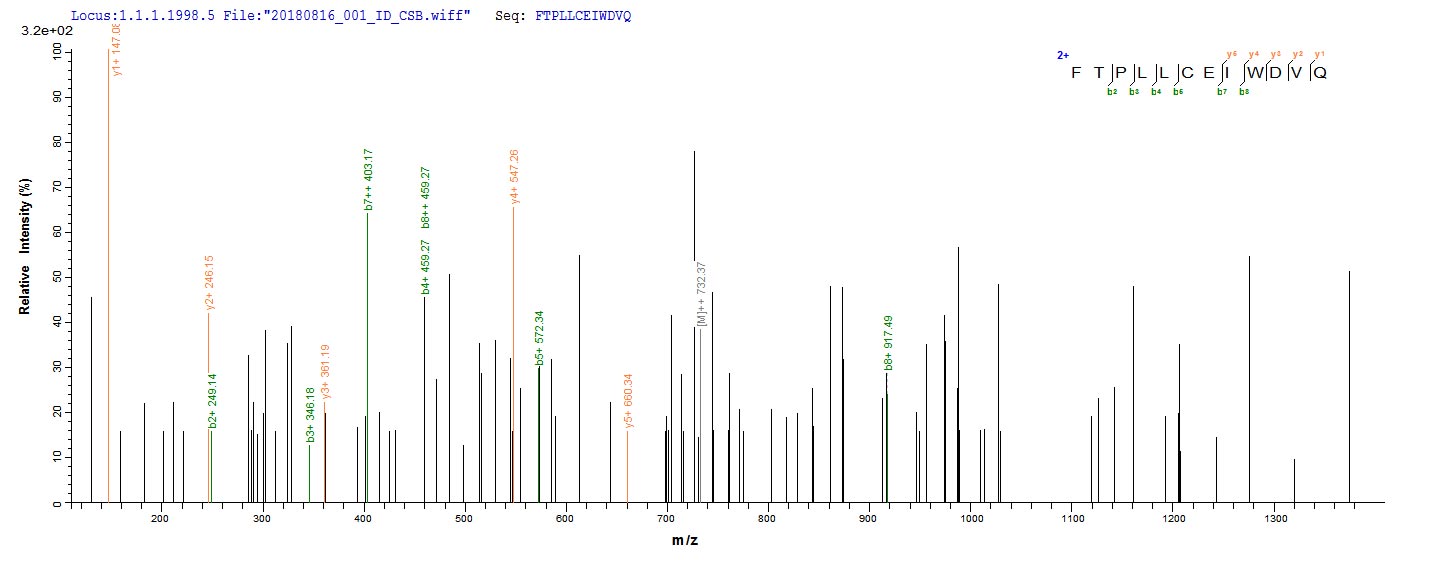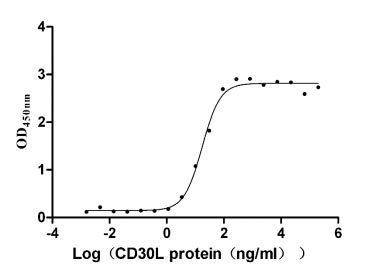Recombinant Human Bile acid receptor (NR1H4)
-
中文名称:人NR1H4重组蛋白
-
货号:CSB-EP839406HU
-
规格:¥1344
-
图片:
-
(Tris-Glycine gel) Discontinuous SDS-PAGE (reduced) with 5% enrichment gel and 15% separation gel.
-
Based on the SEQUEST from database of E.coli host and target protein, the LC-MS/MS Analysis result of CSB-EP839406HU could indicate that this peptide derived from E.coli-expressed Homo sapiens (Human) NR1H4.
-
Based on the SEQUEST from database of E.coli host and target protein, the LC-MS/MS Analysis result of CSB-EP839406HU could indicate that this peptide derived from E.coli-expressed Homo sapiens (Human) NR1H4.
-
-
其他:
产品详情
-
纯度:Greater than 90% as determined by SDS-PAGE.
-
基因名:NR1H4
-
Uniprot No.:
-
别名:BAR; Bile acid receptor; Farnesoid X activated receptor; Farnesoid X receptor; Farnesoid X-activated receptor; Farnesol receptor HRR 1; Farnesol receptor HRR-1; Farnesol receptor HRR1; FXR; HRR 1; HRR1; NR1H4; NR1H4_HUMAN; Nuclear receptor subfamily 1 group H member 4; Retinoid X receptor interacting protein 14; Retinoid X receptor-interacting protein 14; RIP 14; RIP14; RXR interacting protein 14; RXR-interacting protein 14
-
种属:Homo sapiens (Human)
-
蛋白长度:Full Length of Isoform 3
-
来源:E.coli
-
分子量:70.7kDa
-
表达区域:1-476aa
-
氨基酸序列MGSKMNLIEHSHLPTTDEFSFSENLFGVLTEQVAGPLGQNLEVEPYSQYSNVQFPQVQPQISSSSYYSNLGFYPQQPEEWYSPGIYELRRMPAETLYQGETEVAEMPVTKKPRMGASAGRIKGDELCVVCGDRASGYHYNALTCEGCKGFFRRSITKNAVYKCKNGGNCVMDMYMRRKCQECRLRKCKEMGMLAECMYTGLLTEIQCKSKRLRKNVKQHADQTVNEDSEGRDLRQVTSTTKSCREKTELTPDQQTLLHFIMDSYNKQRMPQEITNKILKEEFSAEENFLILTEMATNHVQVLVEFTKKLPGFQTLDHEDQIALLKGSAVEAMFLRSAEIFNKKLPSGHSDLLEERIRNSGISDEYITPMFSFYKSIGELKMTQEEYALLTAIVILSPDRQYIKDREAVEKLQEPLLDVLQKLCKIHQPENPQHFACLLGRLTELRTFNHHHAEMLMSWRVNDHKFTPLLCEIWDVQ
Note: The complete sequence including tag sequence, target protein sequence and linker sequence could be provided upon request. -
蛋白标签:N-terminal 6xHis-SUMO-tagged
-
产品提供形式:Liquid or Lyophilized powder
Note: We will preferentially ship the format that we have in stock, however, if you have any special requirement for the format, please remark your requirement when placing the order, we will prepare according to your demand. -
缓冲液:Tris-based buffer,50% glycerol
-
储存条件:Store at -20°C/-80°C upon receipt, aliquoting is necessary for mutiple use. Avoid repeated freeze-thaw cycles.
-
保质期:The shelf life is related to many factors, storage state, buffer ingredients, storage temperature and the stability of the protein itself.
Generally, the shelf life of liquid form is 6 months at -20°C/-80°C. The shelf life of lyophilized form is 12 months at -20°C/-80°C. -
货期:Basically, we can dispatch the products out in 1-3 working days after receiving your orders. Delivery time may differ from different purchasing way or location, please kindly consult your local distributors for specific delivery time.Note: All of our proteins are default shipped with normal blue ice packs, if you request to ship with dry ice, please communicate with us in advance and extra fees will be charged.
-
注意事项:Repeated freezing and thawing is not recommended. Store working aliquots at 4°C for up to one week.
-
Datasheet & COA:Please contact us to get it.
相关产品
靶点详情
-
功能:Ligand-activated transcription factor. Receptor for bile acids (BAs) such as chenodeoxycholic acid (CDCA), lithocholic acid, deoxycholic acid (DCA) and allocholic acid (ACA). Plays a essential role in BA homeostasis through the regulation of genes involved in BA synthesis, conjugation and enterohepatic circulation. Also regulates lipid and glucose homeostasis and is involved innate immune response. The FXR-RXR heterodimer binds predominantly to farnesoid X receptor response elements (FXREs) containing two inverted repeats of the consensus sequence 5'-AGGTCA-3' in which the monomers are spaced by 1 nucleotide (IR-1) but also to tandem repeat DR1 sites with lower affinity, and can be activated by either FXR or RXR-specific ligands. It is proposed that monomeric nuclear receptors such as NR5A2/LRH-1 bound to coregulatory nuclear responsive element (NRE) halfsites located in close proximity to FXREs modulate transcriptional activity. In the liver activates transcription of the corepressor NR0B2 thereby indirectly inhibiting CYP7A1 and CYP8B1 (involved in BA synthesis) implicating at least in part histone demethylase KDM1A resulting in epigenomic repression, and SLC10A1/NTCP (involved in hepatic uptake of conjugated BAs). Activates transcription of the repressor MAFG (involved in regulation of BA synthesis). Activates transcription of SLC27A5/BACS and BAAT (involved in BA conjugation), ABCB11/BSEP (involved in bile salt export) by directly recruiting histone methyltransferase CARM1, and ABCC2/MRP2 (involved in secretion of conjugated BAs) and ABCB4 (involved in secretion of phosphatidylcholine in the small intestine). Activates transcription of SLC27A5/BACS and BAAT (involved in BA conjugation), ABCB11/BSEP (involved in bile salt export) by directly recruiting histone methyltransferase CARM1, and ABCC2/MRP2 (involved in secretion of conjugated BAs) and ABCB4 (involved in secretion of phosphatidylcholine in the small intestine). In the intestine activates FGF19 expression and secretion leading to hepatic CYP7A1 repression. The function also involves the coordinated induction of hepatic KLB/beta-klotho expression. Regulates transcription of liver UGT2B4 and SULT2A1 involved in BA detoxification; binding to the UGT2B4 promoter seems to imply a monomeric transactivation independent of RXRA. Modulates lipid homeostasis by activating liver NR0B2/SHP-mediated repression of SREBF1 (involved in de novo lipogenesis), expression of PLTP (involved in HDL formation), SCARB1 (involved in HDL hepatic uptake), APOE, APOC1, APOC4, PPARA (involved in beta-oxidation of fatty acids), VLDLR and SDC1 (involved in the hepatic uptake of LDL and IDL remnants), and inhibiting expression of MTTP (involved in VLDL assembly. Increases expression of APOC2 (promoting lipoprotein lipase activity implicated in triglyceride clearance). Transrepresses APOA1 involving a monomeric competition with NR2A1 for binding to a DR1 element. Also reduces triglyceride clearance by inhibiting expression of ANGPTL3 and APOC3 (both involved in inhibition of lipoprotein lipase). Involved in glucose homeostasis by modulating hepatic gluconeogenesis through activation of NR0B2/SHP-mediated repression of respective genes. Modulates glycogen synthesis (inducing phosphorylation of glycogen synthase kinase-3). Modulates glucose-stimulated insulin secretion and is involved in insulin resistance. Involved in intestinal innate immunity. Plays a role in protecting the distal small intestine against bacterial overgrowth and preservation of the epithelial barrier. Down-regulates inflammatory cytokine expression in several types of immune cells including macrophages and mononuclear cells. Mediates trans-repression of TLR4-induced cytokine expression; the function seems to require its sumoylation and prevents N-CoR nuclear receptor corepressor clearance from target genes such as IL1B and NOS2. Involved in the TLR9-mediated protective mechanism in intestinal inflammation. Plays an anti-inflammatory role in liver inflammation; proposed to inhibit proinflammatory (but not antiapoptotic) NF-kappa-B signaling).; Promotes transcriptional activation of target genes NR0B2/SHP (inducible by unconjugated CDCA), SLC51B/OSTB (inducible by unconjugated CDCA and DCA) and FABP6/IBAP; low activity for ABCB11/BSEP (inducible by unconjugated CDCA, DCA and ACA); not inducible by taurine- and glycine-amidated CDCA.; Promotes transcriptional activation of target genes ABCB11/BSEP (inducible by unconjugated CDCA, DCA and ACA), NR0B2/SHP (inducible by unconjugated CDCA DCA and ACA), SLC51B/OSTB (inducible by unconjugated CDCA and DCA) and FABP6/IBAP; not inducible by taurine- and glycine-amidated CDCA.; Promotes transcriptional activation of target genes NR0B2/SHP (inducible by unconjugated CDCA), SLC51B/OSTB (inducible by unconjugated CDCA and DCA) and IBAP; low activity for ABCB11/BSEP (inducible by unconjugated CDCA, DCA and ACA); not inducible by taurine- and glycine-amidated CDCA.; Promotes transcriptional activation of target genes ABCB11/BSEP (inducible by unconjugated CDCA, ACA and DCA), NR0B2/SHP (inducible by unconjugated CDCA, ACA and DCA), SLC51B/OSTB (inducible by unconjugated CDCA and DCA) and FABP6/IBAP; most efficient isoform compared to isoforms 1 to 3; not inducible by taurine- and glycine-amidated CDCA.
-
基因功能参考文献:
- FXR pathway activation increases XBP1 splicing and enhances p-IRE1alpha expression in liver PMID: 29377207
- Activation of FXR inhibits, whereas TGR5 activation may promote, cholangiocarcinoma progression by regulating proliferation, migration and mitochondrial energy metabolism. PMID: 28916388
- study demonstrated for the first time a novel target for farnesoid X-activated receptor (FXR) and that the activated receptor alters the acquisition of sperm fertilising ability PMID: 29921626
- Low FXR expression is associated with colorectal cancer. PMID: 30106441
- Studies indicate that the deregulation of farnesoid X receptor (FXR) may lead to abnormalities of specific organs and metabolic dysfunction [Review]. PMID: 30013008
- FXR agonist treatment enhanced TGF-beta-induced epithelial mesenchymal transition(EMT) morphologic changes and FXR antagonist inhibited the effect of TGF-beta;. Thus, FXR activation enhances EMT in hepatocellular carcinoma (HCC) and FXR antagonists may be EMT-suppressing drug candidates. PMID: 29958417
- This study provides some data suggesting the possible involvement of FXR in the pathophysiology and development of thyroid neoplasms. In particular, we found that there are differences regarding FXR expression between papillary carcinomas and hyperplastic nodules, being also correlated with some patients' clinicopathological parameters. PMID: 28762281
- Data suggest that TGR5 and FXR in intestinal mucosa are important for glucose homeostasis, in particular in metabolic disorders such as type 2 diabetes and obesity. (TGR5 = membrane-type receptor for bile acids TGR5; FXR = farnesoid X receptor) [REVIEW; Congress as Topic] PMID: 27846919
- These results suggested that FXR may serve as an important negative regulator for manipulating Smad3 expression, and the FXR/Smad3 pathway may be a novel target for the treatment of renal fibros PMID: 27853248
- Loss of FXR or its down-regulation is associated with higher bile acids concentrations and with a pro-tumorigenic phenotype. (Review) PMID: 28400119
- Lys-325 is a non-canonical site of SUMOylation of human FXR.CK2 is the priming effector that phosphorylates Ser-327, resulting in enhanced SUMO2 conjugation, which then directs the ubiquitination and degradation of FXR through the recruitment of the SUMO-dependent ubiquitin E3 ligase RNF4. PMID: 28201649
- we proposed a model to link FXR to Sp1, which included triggered FXR, p38/MAPK and/or PI3K/AKT signaling and phosphorylated Sp1, to illustrate the potential crosstalk between the two factors. PMID: 28402278
- the presented evidence suggested that WA can inhibit HCC cell proliferationand tumorigenesis through miR-22-repressed CCNA2, which was at least partially through FXR regulation PMID: 27738335
- The results indicated that epigenetically regulated miR-449a targets CREB5 to increase FXRalpha expression, thereby promoting HBV replication and gene expression. Our findings provide a new understanding of the role of miRNAs in HBV replication PMID: 27138288
- In diabetic humans, there is decreased FXR expression in the kidney. FXR plays an important role in Diabetic Kidney Disease. PMID: 27045028
- FXR regulates serum triglyceride level in part through PLA2G12B. PMID: 27471003
- It regulates the growth of renal adenocarcinoma cells. PMID: 28496032
- we conclude that FXR-Gank-TSPs-Stem cells pathway is a key determinant of liver cancer in animal models and in pediatric liver cancer. Our data provide a strong basis for development of FXR-Gank-based therapy for treatment of patients with hepatoblastoma PMID: 28535186
- PPARalpha and FXR function coordinately to integrate liver energy balance. PMID: 28287408
- These studies investigated in differentiated HepaRG cells and in primary human hepatocytes (PHHs) effects of FXR activation on HBV replication and of infection on the FXR pathway. PMID: 27251172
- Treatment with LXR and FXR ligands initiates coated platelet formation, which is thought to support coagulation but results in desensitization to platelet stimuli through inhibition of alphaIIbbeta3 consistent with their ability to inhibit platelet function and stable thrombus formation in vivo. PMID: 28619996
- FXR ligands to inhibit platelet activation. PMID: 27758768
- Taken together, our data provide the first evidence that FXR suppresses proliferation of human liver cancer cells via the inhibition of the mTOR/S6K signaling pathway. FXR expression can be used as a biomarker of personalized mTOR inhibitor treatment assessment for liver cancer patients. PMID: 27109477
- Activated FXR inhibits leptin signaling and counteracts tumor-promoting activities of cancer-associated fibroblasts in breast malignancy. PMID: 26899873
- FXR may promote the proliferation of tumor cells and the hepatocytes in the process of liver regeneration by activating the PDK4-mediated metabolic reprogramming to generate glycolytic intermediates essential for rapid biomass generation, establishing a mechanistic link between cell proliferation and metabolic switch. PMID: 26728993
- this is the first report of bile acid derivatives able to antagonize GPBAR1 and and farnesoid X receptor (FXR) modulatory activity. PMID: 26607331
- induction of SOCS3 may be a novel mechanism by which FXR exerts its anti-hepatocellular carcinoma effects PMID: 26416445
- Mutations in NR1H4 cause progressive familial intrahepatic cholestasis. PMID: 26888176
- we drew a conclusion that curcumin attenuated Alcoholic liver disease by modulating lipid deposition in hepatocytes via a Nrf2/FXR activation-dependent mechanism PMID: 26305715
- miR-122 is a novel target gene of FXR, and the upregulation of miR-122 by FXR represses the growth of hepatocellular carcinoma cells, suggesting that FXR may serve as a key transcriptional regulator for manipulating miR-122 expression PMID: 26302777
- IL-18 repressed FXR mRNA and protein levels in HepG2 cells. PMID: 26292095
- FXR signalling in ileum biopsies of humans positively correlates with body mass index. PMID: 26670557
- FXR activation in L cells decreases proglucagon expression by interfering with the glucose-responsive factor Carbohydrate-Responsive Element Binding Protein (ChREBP) and GLP-1 secretion by inhibiting glycolysis. PMID: 26134028
- FXR is decreased in obese animal models associated with INS resistance. Regulation of bile acids and FXR in the stage of obesity may prevent more metabolism disorders. PMID: 26488943
- These results provide important information to prioritize chemicals for further investigation, and suggest possible modes of action of compounds in FXR signaling. PMID: 25257666
- FXR may regulate SOD3 expression to suppress reactive oxygen species production, resulting in decreasing JNK activity. PMID: 25496033
- Liver nuclear receptors, FXR and SHP, and bile acid transporters, NTCP and BSEP, are associated with the progression of NAFLD. PMID: 26019035
- Three FXR gene variants (rs35724, rs11110385, rs11110386) were identified as potential susceptibility factors for cholelithiasis in a German cohort in gender- and weight-dependent manners PMID: 25242139
- these data demonstrate that copper-mediated nuclear receptor dysfunction disrupts liver function in WD and potentially in other disorders associated with increased hepatic copper levels. PMID: 26241054
- FXR agonist, GW4064, upregulates adipokine expression in preadipocytes and HepG2 cells. PMID: 25400456
- NHR1H4 genotype increases the risk for spontaneous bacterial peritonitis in live cirrhosis patients. PMID: 25086996
- Results show that HRG is a novel transcriptional target gene of FXR in human hepatoma cells, human upcyteVR primary hepatocytes and 3D human liver microtissues in vitro and in mouse liver in vivo. PMID: 25363753
- established genome-wide human FXR binding and transcriptome profiles. These results will aid in determining the human FXR functions, as well as judging to what level the mouse models could be used to study human FXR functions PMID: 25198545
- our data showed that bile acid-activated FXR stimulates miR-22-silenced CCNA2, a novel pathway for FXR to exert its protective effect in the gastrointestinal tract. PMID: 25596928
- AB23A produces protective effect against ANIT-induced hepatotoxity and cholestasis, due to FXR-mediated regulation of transporters and enzymes. PMID: 25655198
- Compared with normal gallbladder tissues, FXR expression was decreased and MCL1 expression was increased in GBC, during progression of tumor node metastasis (TNM) stage PMID: 25043081
- Intestinal nuclear bile acid farnesoid X receptor is regulated transcriptionally by CDX2. PMID: 25138215
- significant differences at the distal (-1890) and proximal promoter (-358) CpG sites of the FXR/NR1H4 and at the distal PXR/NR1I2 (-1224) promoter, which were consistently less methylated in ICP cases when compared with controls. PMID: 24498169
- show that FXR interacts with and is O-GlcNAcylated by O-GlcNAc transferase in its N-terminal AF1 domain PMID: 24037988
- NR1H4 methylation is associated with colon cancer. PMID: 24169962
显示更多
收起更多
-
相关疾病:Cholestasis, progressive familial intrahepatic, 5 (PFIC5)
-
亚细胞定位:Nucleus.; [Isoform 1]: Nucleus.; [Isoform 2]: Nucleus.; [Isoform 3]: Nucleus.; [Isoform 4]: Nucleus.
-
蛋白家族:Nuclear hormone receptor family, NR1 subfamily
-
组织特异性:Liver and hepatocyte-related cells express mainly FXRalpha1-type isoforms with isoform 3 and isoform 4 in approximately equal proportions. In intestine and kidney mainly FXRalpha2-type isoforms are expressed with isoform 1 and isoform 2 in approximately e
-
数据库链接:
HGNC: 7967
OMIM: 603826
KEGG: hsa:9971
STRING: 9606.ENSP00000447149
UniGene: Hs.282735
Most popular with customers
-
Recombinant Human Tumor necrosis factor receptor superfamily member 8 (TNFRSF8), partial (Active)
Express system: Mammalian cell
Species: Homo sapiens (Human)
-
Recombinant Human Semaphorin-4D (SEMA4D), partial (Active)
Express system: Mammalian cell
Species: Homo sapiens (Human)
-
Recombinant Human Claudin-6 (CLDN6)-VLPs (Active)
Express system: Mammalian cell
Species: Homo sapiens (Human)
-
Recombinant Human Tumor-associated calcium signal transducer 2 (TACSTD2), partial (Active)
Express system: Mammalian cell
Species: Homo sapiens (Human)
-
Recombinant Human Tumor necrosis factor ligand superfamily member 15(TNFSF15) (Active)
Express system: Mammalian cell
Species: Homo sapiens (Human)
-
Express system: Mammalian cell
Species: Homo sapiens (Human)







-AC1.jpg)

-AC1.jpg)











